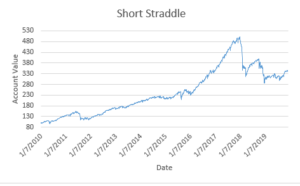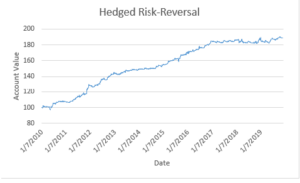-
- January 4, 2021
- 0
The Risk-Reversal Premium
One of the first contributions of modern finance was to categorize returns into alpha and beta. Loosely speaking, beta returns were those that could be passively replicated with a broad market position, and alpha was excess returns above this. That was 60 years ago. Since then, the idea has been extended into “smart beta”, where it has been recognized that many things that looked like alpha were actually just beta with respect to a factor other than the broad market. The original factors were value and size in the Fama-French model, but there are now many such factors and smart beta is a well established idea.
Beta is also present in the option world. The most well-known example is the variance premium: the tendency of the implied volatility to over-estimate the subsequent realized volatility. This can be monetized in numerous ways. We can sell variance or volatility swaps. We can use VIX futures or ETFs. Or we can sell and delta-hedge options. Using OptionMetrics data, I tested a very simple strategy of selling a two-month straddle, re-balancing weekly and closing with two weeks until expiration. Results are shown below.

CAGR (on Reg T margin): 12.44%
Sharpe Ratio: 0.67
But as I wrote above, there are many ways to profit from the variance premium and they all work in slightly different ways. For example, the straddle strategy doesn’t benefit from the OTM puts having much higher implied volatilities than the ATM options. So, just as equity beta has been decomposed into many different betas, we can find volatility sub-betas. One of these is the risk-reversal premium, captured by selling OTM puts and buying the cheaper OTM calls. I deliberately don’t call this the skew premium. The profit of a hedged risk-reversal mainly depends on the correlation between the volatility and the underlying. Realized skewness plays only a minor role. Using the same general parameters as for the straddle strategy, the results of a hedged 25-delta risk reversal are:

CAGR: 6.43%
Sharpe Ratio: 1.18
Even without doing any statistics, these are clearly different return streams. A portfolio can benefit from the inclusion of both.

LEAVE A COMMENT